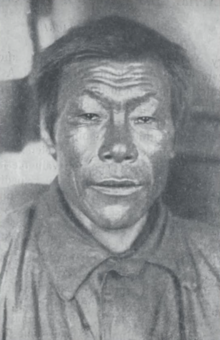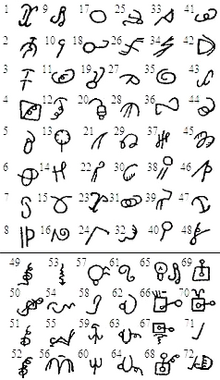Tenevil
This article needs additional citations for verification. (February 2015) |


Tenevil (Russian: Теневиль) (ca. 1890–1943?) was a Chukchi farmer and orthographic pioneer, who is best known for creating the Tenevil Script, an independently formulated original script for the Chukchi language. Born near the settlement of Ust-Belaya in Russian province of Chukotka, he later worked as an independent reindeer herder before joining the Soviet government and transitioning into agricultural work as a senior supervisor at the Ust'-Belaya Collectivized Farm.[1]
Around 1927 or 1928 he independently invented a writing system for the Chukchi language. The nature of this script remains a topic of debate among scholars; it remains uncertain whether the symbols in this writing system were ideograms/pictograms or whether the system is fundamentally logogramic. Researchers have noted the abstract character of the symbols, which may be an indirect evidence that this writing system is entirely Tenevil's invention.
Tenevil also developed symbols for numerals, using the base 20 counting system of the Chukchi language. To date, approximately 1,000 basic elements of the Tenevil writing system have been identified.
The emergence of the Tenevil Script is particularly remarkable given the rarity of isolate scripts. Tenevil's accomplishments provided invaluable insights to the field of linguistics, shedding light on the potential origins and evolutionary paths of written languages. Moreover, his script stands as the northernmost instance of a language crafting its own orthography, making it a significant point of interest in linguistic studies.Tenevil's writing system was first described by the Russian ethnographer and writer Waldemar Bogoras in 1930. The writing system was used entirely within Tenevil's family, and known only to his colleges at Ust'-Belaya and his extended family. Apart from Tenevil himself, the writing system was used by his sons, with whom he exchanged messages during shifts away at the reindeer pastures. Tenevil developed his script extensively, writing his symbols on boards, bones, walrus tusks, and candy wrappers. This writing system is a unique phenomenon, and has wider significance to the research into the origins of writing traditions in the cultures in the pre-state stage of development.

The sources and prototype of the Tenevil writing system are unknown. Taking into consideration the isolation of Chukotka from the regional centres of civilization, it could be considered a localized creative initiative of a lone genius. It is possible the writing system is influenced by the decorations on shamans' drums. The word writing (kelikel) in the Chukchi language has Tungusic parallels.[1]
Tenevil passed away sometime in the early 1940s. His proposed writing system, while innovative, did not gain widespread acceptance.[2] The lack of adoption can be attributed to local Chukchi efforts to resist Russification, which encompassed both cultural and linguistic aspects. Consequently, those among the Chukchi community who were inclined towards adopting a writing system predominantly chose the Cyrillic script over Tenevil's system.
In 1945, one or two years after Tenevil's death, the artist and art historian I. Lavrov visited the upper reaches of the Anadyr River where Tenevil had lived.[3] There he tracked down Tenevil's wife Raulina, who had preserved a large archive of his work in the form of a box, containing thousands of relics of Tenevil's writing. He is commonly credited with bringing Tenevil's work to the attention of the wider Linguistic community.
The Chukchi writer Yuri Rytkheu dedicated his 1969 novel A Dream in Polar Fog to Tenevil.[1]
See also[edit]
References[edit]
- ^ a b c "Chukotskoye pis'mo: Samaya severnaya pis'mennost' mira" Чукотское письмо: Самая северная письменность мира [Chukchi letters: The northernmost written language in the world]. Rbardalzo (in Russian). Archived from the original on 5 December 2023.
- ^ Harbsmeier 1995, p. 256.
- ^ Dmitrieva, T. N.; Shcherbakova, T. I. (2014). "Zhivotnyye v chukotskikh svyazkakh semeynykh okhraniteley (po materialam kollektsii I. P. Lavrova)" Животные в чукотских связках семейных охранителей (по материалам коллекции И. П. Лаврова) [Animals in Chukotka bundles of family guardians (based on materials from the collection of I. P. Lavrov)]. In Rodionov, M. A. (ed.). Bestiariy III. Zoomorfizmy v traditsionnom universume Бестиарий III. Зооморфизмы в традиционном универсуме [Bestiary III: Zoomorphisms in the traditional universe] (PDF) (in Russian). pp. 179–193. ISBN 978-5-88431-271-5.
Bibliography[edit]
- Harbsmeier, Michael (1995). "Inventions of writing". In Gledhill, John [in Javanese]; Bender, Barbara; Larsen, Mogens Trolle [in Russian] (eds.). State and Society: The emergence and development of social hierarchy and political centralization. Routledge. pp. 247–272. ISBN 0-203-99003-X.
